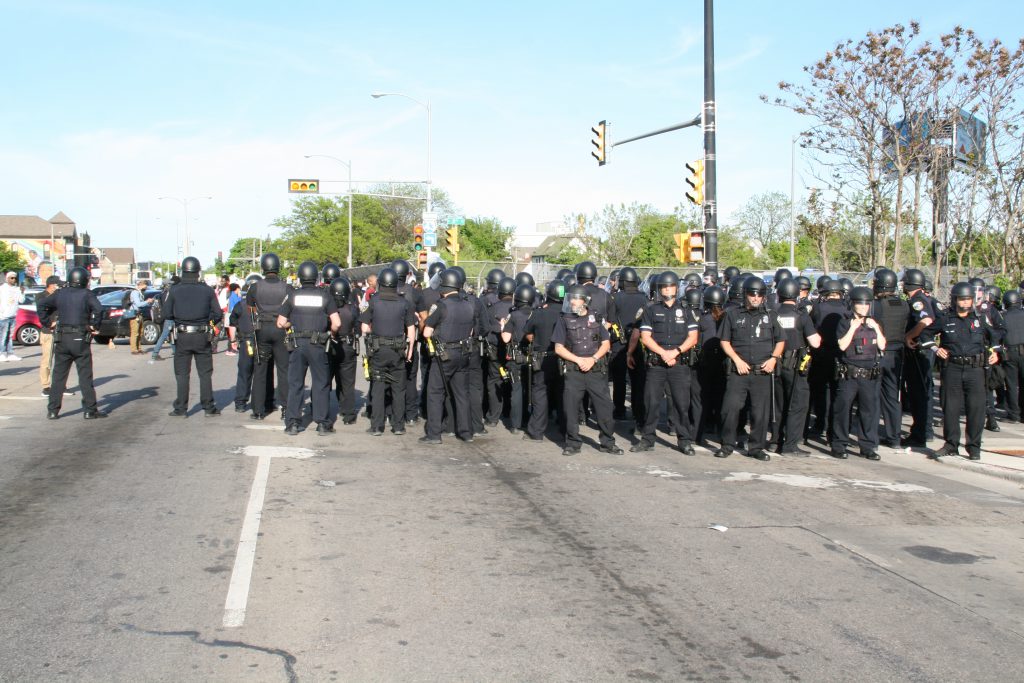120 Officer Cut May Be Just The Beginning
The Milwaukee Police Department will have fewer officers in 2021, but the question is how many?

Milwaukee Police Department officers block a freeway on-ramp from protesters. Photo by Jeramey Jannene.
The Milwaukee Police Department is going to face a budget cut in 2021, but how large it is and how many officers are cut remains the big question. One proposal would reduce the size of the department by over 120 officers.
The Common Council requested the city budget office study a 10 percent reallocation, or approximately $30 million, from the department towards other public health and safety initiatives. But even without the cut, the city faces a budget that Mayor Tom Barrett and others are calling the most difficult in at least a decade.
“There is no way we would be able to afford the same police staff we have under the scenario that is facing us,” said city budget director Dennis Yaccarino during a Common Council Steering & Rules Committee meeting Thursday afternoon. “There will be significant cuts to the police department outside of the effort to cut 10 percent.”
State law limits how much the city can increase its property tax levy in a given year and Yaccarino estimated in 2021 that would be a maximum of $8 million. City department budget requests, targeted at maintaining existing operations, include a call for $68 million in increased funding.
So what to do?
One proposal Yaccarino has modeled is not replacing any officers that retire or leave the force through the end of 2021. That would avoid layoffs and reduce the sworn strength by approximately 150, a $10.6 million savings. A federal COPS grant would fund an approximately 30-member recruiting class, reducing the staffing reduction to 120 by the end of 2021.
“We are currently looking at that number, we haven’t come to a conclusion on this point,” said Yaccarino of Mayor Tom Barrett’s intent to include that in his executive budget proposal due September 22nd.
A similar method is being used in 2020 to reduce sworn strength by 60 officers.
“It’s not just a transactional relationship with calls for service,” said Alderwoman Marina Dimitrijevic. And she said spending on other public health measures would reduce the number of calls for service.
Yaccarino’s report suggested a few other areas for change, many of which don’t yield immediate savings but do shrink the MPD budget.
One is a proposal to consolidate the 911 and computer-aided dispatch (CAD) systems for both the police and fire departments into a single operation. “We expect those both to be in place by the end of 2021,” said Yaccarino. It would reduce the police budget by $23 million, but generate no citywide savings in 2021. It would replace sworn personnel positions with civilian positions, which would yield long-term cost savings on a one-to-one basis.
Ald. Nik Kovac said the move would also give the city more flexibility in its emergency response going forward. Yaccarino said it would improve the quality of data and cross-training dispatchers for both police and fire qualities would yield productivity increases. “We are also hoping the new system gives us better reporting,” he said.
Another proposal would move the Internal Affairs section from MPD into a separate, independent department. It currently consists of 31 sworn positions. Yaccarino said moving the unit, which investigates administrative conduct of MPD members, would not necessarily yield immediate savings and could take years to implement, but would increase transparency.
Yaccarino also suggested going further with special event fees. The council approved a change in February that would require large events to pay for any associated personnel costs. His report notes that MPD spent 14,511.4 hours on special events in 2019, primarily on traffic control. “If there is a need for police at the event, we should charge the event,” he said.
Community Service Officers
The budget office report recommends expanding the use of civilian service officers (CSO).
There are currently 25 authorized CSO positions, but only nine are filled. “Some of that is because of budget restrictions,” said Yaccarino.
A CSO does not have arrest powers and is not covered by the rank-and-file union contract, but can perform a number of police duties particularly in responding to incidents where only property damage occurs.
“The police, through their union, have step increases on an annual basis. There is uncertainty whether the CSOs will increase on an annual basis,” said Yaccarino, suggesting that savings could grow over time.
For the cost of two police officers the city can hire three civilian service officers.
“If you could take off 20 percent of the calls for service and divert them to a cheaper version of a police officer… you may not see an increase in response time,” said Ald. Michael Murphy in calling for more data on calls for service.
The city fielded approximately 173,000 calls for service in 2019.
The report, without giving a specific example, also calls for replacing other sworn personnel positions with civilian personnel that are still part of MPD.
Alternative Response to Non-Criminal Calls
One area that council members and Yaccarino agreed warrants further discussion is the response to incidents like mental health emergencies.
According to the budget office report, the average mental health call lasts one hour and 43 minutes. The 8,141 such calls in 2019 consumed the equivalent of seven full-time police officers for the entire year.
In 2013, Milwaukee County’s Behavioral Health Division (BHD) in partnership with MPD launched the Crisis Assessment Response Team or CART, which pairs a BHD clinician with an MPD office for responses to mental health crises.
Wisconsin state law requires law enforcement officers to initiate any involuntary mental health treatment, a requirement that puts it in a small minority says the report. A long-term solution would be amending that law, according to the report.
A Straight 10 Percent Cut?
Simply slashing the money from the budget isn’t as straightforward as it might seem. It would result in other costs and potentially unforeseen consequences that require additional modeling, Yaccarino said.
There is a belief within City Hall that the diversity in the force comes primarily from younger officers with less experience and layoffs would make the force less reflective of the minority-majority city it represents. “[The Milwaukee Police Association] requires us to go first in, first out,” said Yaccarino of the union contract. “We would have to take a look at that and analyze that to confirm that.”
Layoffs would also cause a hit to the city’s unemployment compensation fund.
“If you all had to cut 10 percent today, would the proposal look the same as what you’re showing us today?” asked Alderwoman Milele A. Coggs. Yaccarino said he didn’t look at it that way.
Coggs asked why the report didn’t include proposals to cut funding for new squad cars and other surveillance equipment, things, she said, the council often found itself debating during the budget process.
The budget director said those things are under review. “It won’t be necessarily what you see in front of you,” said Yaccarino of the budget proposal.
“We are looking at running a system the same way it has always been run, maybe the point is to change the system,” said Coggs.
But even if MPD operates on a smaller budget, it isn’t clear how much would be available to be spent elsewhere.
“I think what we’re hearing from Mr. Yaccarino is there will be very little money to reinvest in anything,” said Ald. Robert Bauman.
“Right now is our challenge we are not getting a lot of help from the state,” said Yaccarino. State shared revenue has been cut by over $100 million per year, accounting for inflation, since 2003.
Bauman said in his time on the council, dating back to 2004, the police department’s share of the budget has increased because the city has made cuts to other departments. “We have resisted the same level of cuts that different departments have had to absorb,” said Bauman. “I see this primarily as a revenue problem.”
Barrett is scheduled to present an executive budget proposal to the council on Sept. 22. The council will spend the next month reviewing and amending it before adopting a final budget in early November.
A full copy of the report can be found on Urban Milwaukee.
If you think stories like this are important, become a member of Urban Milwaukee and help support real, independent journalism. Plus you get some cool added benefits.
More about the 2021 Milwaukee Budget
- City Hall: Council Delays on Federal COPS Grant - Jeramey Jannene - Nov 25th, 2020
- City Hall: Council Overrides One of Two Barrett Vetos - Jeramey Jannene - Nov 24th, 2020
- City Hall: Barrett Issues Two Budget Vetoes - Jeramey Jannene - Nov 18th, 2020
- City Hall: $1.6 Billion Adopted Budget Raises Fees, Cuts Police - Jeramey Jannene - Nov 6th, 2020
- Transportation: Budget Amendment Would Move Milwaukee Towards “Vision Zero” - Jeramey Jannene - Oct 30th, 2020
- City Hall: Committee Approves Over 20 Amendments To Milwaukee Budget - Jeramey Jannene - Oct 30th, 2020
- City Hall: Almost Half of Budget Amendments Are Policy Footnotes - Jeramey Jannene - Oct 29th, 2020
- City Hall: Community Groups Propose Changes - Jeramey Jannene - Oct 19th, 2020
- City Hall: City Could Lose 30 More Police Officers - Jeramey Jannene - Oct 19th, 2020
- Transportation: Should Milwaukee Stop The Hop? - Jeramey Jannene - Oct 13th, 2020
Read more about 2021 Milwaukee Budget here
Political Contributions Tracker
Displaying political contributions between people mentioned in this story. Learn more.
- March 28, 2016 - Michael Murphy received $100 from Terry Witkowski
- November 19, 2015 - Robert Bauman received $50 from Terry Witkowski
City Hall
-
Council Blocked In Fight To Oversee Top City Officials
 Dec 16th, 2025 by Jeramey Jannene
Dec 16th, 2025 by Jeramey Jannene
-
Latest Effort to Adopt New Milwaukee Flag Going Nowhere
 Dec 3rd, 2025 by Jeramey Jannene
Dec 3rd, 2025 by Jeramey Jannene
-
After Deadly May Fire, Milwaukee Adds New Safety Requirements
 Dec 2nd, 2025 by Jeramey Jannene
Dec 2nd, 2025 by Jeramey Jannene





















Given the lack of inflation in the economy, there is zero necessity for these disastrous cuts. It is being entirely driven by the GOP Congress which refuses to direct sufficient aid to backstop fiscal holes in city and state budgets. This is early Great Depression economics at its worst…